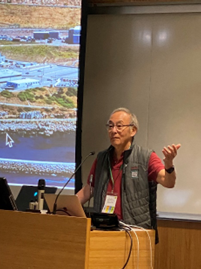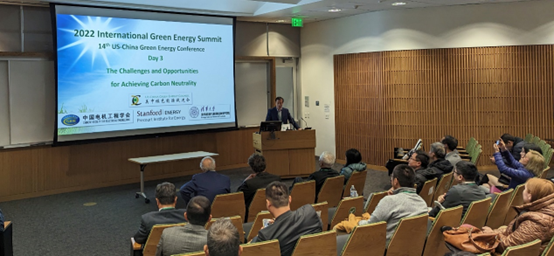The 14th China-US Green Energy Summit (aka. 2022 International Green Energy Summit) was successfully held on Dec. 1st-3rd, 2022. The theme of this high-level international conference was Opportunities and Challenges on the Road to Carbon Neutrality. Facing with the urgency of tackling the climate crisis, world’s top-tier scientists and energy leaders from US, China, and Europe gathered together, to discuss ideas, methods and paths for achieving carbon neutrality, and to promote international cooperation.
The Summit was co-sponsored by the US-China Green Energy Council, Stanford Precourt Institute for Energy, the Chinese Society of Electrical Engineering, and the Energy Internet Research Institute of Tsinghua University.
The Lieutenant Governor of California, Eleni Kounalakis sent a congratulatory letter to the summit, highly recognizing the US-China Green Energy Council’s dedication to develop an international platform on promoting green energy development and fostering collaboration on climate change. She addressed California and China working together have built a strong track record of collaboration on climate change and environmental protection. As two of the world’s largest economies, California and China have reaffirmed the commitment to work together to hasten our transition to a carbon-free future. The Consul General of China at San Francisco, Jianmin Zhang also sent a congratulatory letter to the conference.
The Chairman and CEO of US-China Green Energy Council (UCGEC), Qi Wang said in his opening remarks that achieving carbon neutrality requires an integrated system design, the key of which is one core and two supports. The one core is to take technology innovation as the core. A low-carbon technology innovation system based on global collaboration needs to be developed. The two supports are the supports from carbon-neutrality oriented policy and green investment, so to promote green, low-carbon transformation and carbon neutral systemic change.
A new book titled with The Energy Technology Innovation on the Path towards Carbon Neutrality was released during this summit. It is edited by Dr. Qi Wang, Chairman and CEO of UCGEC, and Prof. Chongqing Kang, Director of Energy Internet Research Institute of Tsinghua University. There are more than twenty contributing authors of this book including Nobel laureate, academicians, thought leaders, government officials and industrial technology experts. The book covers the frontier technologies and development trends in key areas for achieving carbon neutrality, including zero-carbon transformation of power system, clean and intelligent transportation, hydrogen energy and energy digitization. The honorary chairman of China Society for Science and Technology, Academician Qide Han, and the Nobel laureate, Prof. M. Stanley Whittingham wrote forewords to recommend this book.

The keynote session in the 1st day of the Summit has attracted nearly 10,000 online audiences to listen to the insights of top experts on carbon neutrality. Steven Chu, Nobel laurate in Physics and the 12th Secretary of Energy of the United States, delivered keynote speeches on the opportunities and challenges of clean energy transition and a more sustainable future. He addressed it is not easy to remove GHG emissions from all sectors such as steel, cement and the whole supply chain food. Innovative technologies are required for the energy storage, hydrogen, agriculture and more, Prof. Chu also pointed out that nuclear power is actually a safe and clean energy which could be used as a compact energy-on-demand energy source for clean energy transition. He also urged to redefine the definition of wealth in order to create a more sustainable future.
Yi Cui, Director of Stanford Precourt Institute for Energy listed in his keynote the top ten clean energy technologies needed for achieving Carbon Neutrality, including long-term energy storage, high energy density and low-cost batteries, carbon capture and carbon removal, renewable fuels, digital energy, low-carbon steel, low-carbon cement, plastic recycling, sustainable food and nuclear energy. Shu Yinbiao, academician of the Chinese Academy of Engineering and chairman of the Chinese Society of Electrical Engineering, said China's energy should implement the four modernizations transformation path of clean, electrification, digitalization and standardization, so as to form a multi-energy complementary clean energy supply system. Timur Gül, head of energy technology policy at the International Energy Agency, presented the IEA roadmap to carbon net-zero by 2050. He addressed about 50% of carbon reduction must rely on the emerging technologies and international cooperation is essential to achieve carbon net-zero.
Mary Nichols, the former chairman of the California Air Resources Board discussed the challenges of carbon neutrality in a fireside chat. She reviewed in her over decades of leadership role at CARB how California successfully reduced GHG emissions while growing economy, by implementing many of first-of-its-kind policies, standards and programs on fuel, zero-emission vehicles and other climate programs. She also shared her recent experiences at COP27 and how California may continue to tackle climate risks. Mary addressed in the end of her conversation that we cannot deal with climate change in vacuum, we must work together in worldwide to achieve our common goal. The fireside chat was moderated by Dr. Robert Weisenmiller, the former chairman of California Energy Commission.

The second day of the summit was a special forum on energy storage technology, which was held in Shanghai, China. On the third day of the summit, a special forum on clean energy transformation was held at Stanford University. Robert Weisenmiller, former chairman of the California Energy Commission, gave a speech on California's Innovative Climate and Energy Policy, Xiaoxin Zhou, the honorary chairman of the China Electric Power Research Institute, presented on the flexibility and resilience of the new power system. Larry Goulder, Director of Environmental and Energy Policy Analysis Center at Stanford University, talked about China's extraordinary way of reducing carbon emissions. In addition, Stanford Precourt Institute for Energy and the Lawrence Berkeley National Laboratory released research reports on Accelerating the Decarbonization Process between China and the United States and Promoting Bilateral Climate Change Cooperation and Achieving 80% Zero Carbon Power System in China by 2035 respectively.
The US-China Green Energy Council (UCGEC) is a 501 (C) (3) non-profit organization based in San Francisco Bay Area. Since founded in 2008, the Council has established a well-recognized platform for promoting technology innovation and international collaboration for green energy and climate change. (www.ucgec.org )
Media Contact
Company Name: US-China Green Energy Council
Contact Person: Sam Wang
Email: Send Email
Country: United States
Website: www.ucgec.org














